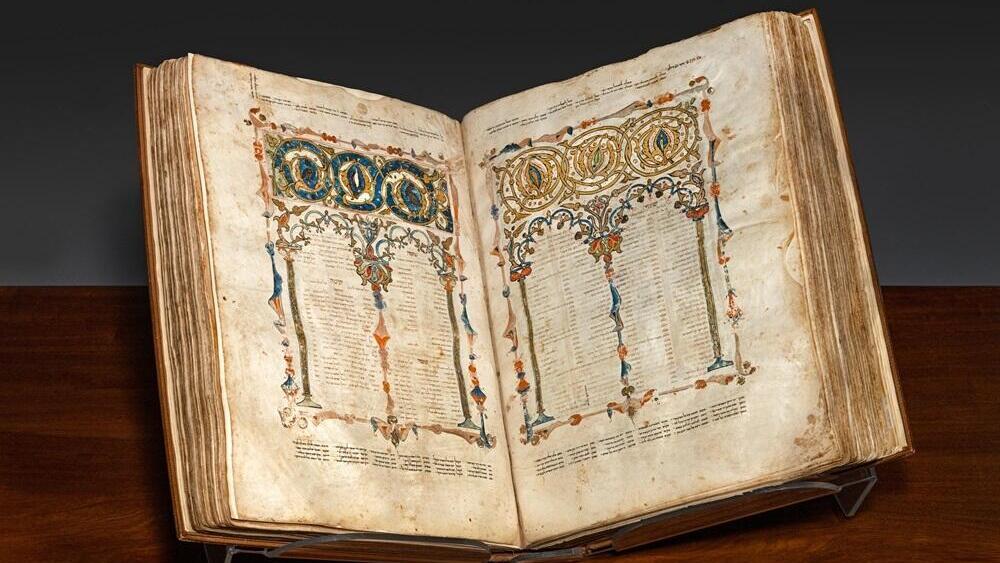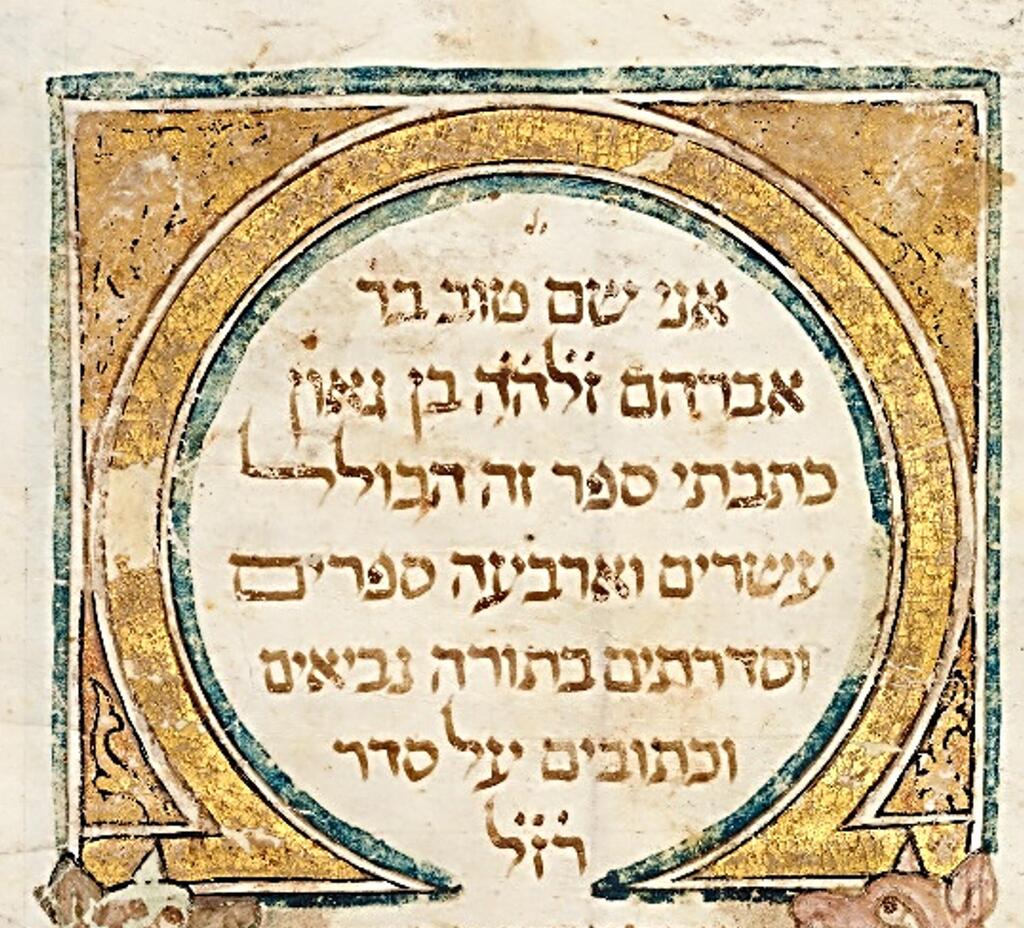The National Library of Israel will now present to the public the Shem Tov Bible, a rare and precious copy of the bible, written in the 14th century by Rabbi Shem Tov ben Abraham Ibn Gaon, a great scholar of Jewish law and mysticism, and one of the greatest rabbis of medieval Spain.
"On Shavuot, the people of Israel received the Torah, and on the occasion of the holiday that will fall next week, this book is returning to the people of Israel," says Dr. Chaim Neria, curator of the Haim and Hanna Solomon Judaica Collection at the National Library of Israel.
To understand the great importance of this book, we need to go back to the history of the Jewish people. For about 2,000 years, the biblical text, which was copied over and over again, was written with quill and ink on parchment, but without punctuation, punctuation marks or biblical accents. These tools, which allow us to understand the Hebrew text, were invented much later, by the Masoretic scholars, who wanted to enable the transmission of the correct pronunciation rules in writing. Until their time, the tradition was passed down orally, from master to disciple and from father to son.
"Until the invention of printing, copying the Bible accurately required strenuous work," explains Neriah. "It also required a lot of money to buy parchment, which was produced by processing animal skins, such as cows and deer."
Rabbis did not usually have much money.
"So wealthy patrons would pay to have the Bible copied for them, but it belonged to them. Later, the process was shortened a bit, with the invention of the codex. Instead of copying the text onto a parchment scroll that was written on one side and rolled up, they began to create books that contained parchment pages bound into a book. The pages were written on both sides and then bound. This also greatly reduces the amount of parchment needed and has an educational advantage; when reading a book, you can flip to another section and compare texts, which is impossible to do with a scroll. Since in the past the word 'book' was used to describe what was written on a scroll, as we today call a Torah scroll, when the Bible was written as a bound book they called it a 'keter', such as 'keter Aram Zuba', and only later did the bound book come to be called a book. Incidentally, in Arabic, the bound book is called ta'aj, a nickname that is still common among Yemenites," the curator says.
"Rabbi Shem Tov ben Abraham Ibn Gaon, completed the copying of the Bible in Castile, Spain, in 1312. First of all, it must be noted that he was one of the greatest rabbis and sages of Spain, who was also well-versed in occult wisdom, and also authored 'Migdal Oz,' a very important commentary on the 'Mishnah Torah' written by Maimonides, a work that every yeshiva student knows. The way he copied the Bible was extraordinary. He did not have a patron, but rather financed the purchase of the expensive parchment with his own money, and labored for about a decade to copy the text from an authentic copy. For him, copying the text was a kind of 'worship of God', and he also continued to correct the text throughout his life," according to Neria.
"He testifies that he went over the text dozens, if not hundreds, of times to make sure there were no mistakes, and when he discovered errors, he corrected them. His copy includes the preservation of an ancient tradition of precise writing of words, such as the word 'Vayikra' which is written in a Torah scroll with a small 'A', or special notation of strange letters, such as curling the inner part of the letter 'P', something called 'P"A to 'Pupa'."
A genius and an artist
It turns out that Rabbi Shem Tov was not only a Torah genius, but also a magician. The pages of the book are decorated with colorful illustrations of images from the world of flora and fauna, imaginary creatures, as well as symmetrical structures of arches and symbolic images. Some of the style of the decorations was influenced by Muslim culture.
After completing the copying of the Bible, Rabbi Shem Tov took the precious book with him and set out on a journey to the Land of Israel, where he arrived in 1315. He continued to write and create until he died around 1330, at the age of about 43.
Neria notes that for centuries the manuscript wandered throughout the Middle East and North Africa, where it was even attributed mystical powers. Unfortunately, several pages were lost from the book, torn from it, possibly to be used, for example, as a charm to ease childbirth.
The famous collector David Salomon Sassoon purchased the book in 1909, but after his death the manuscripts he had collected were sold. In 1994, the famous banker Yaakov (Jacques) Safra purchased the Shem Tov Bible for $825,000. About three decades passed, and in 2024 the book was up for auction at Sotheby's, and was purchased by Terry and Andrew Herenstein for $6.9 million . The couple agreed to a long-term loan so that this rare copy could be displayed at the National Library of Israel.
'Closes a circle'
“Receiving this manuscript, especially at the time of Shavuot, which celebrates the giving of the Torah, is profoundly significant," says Sallai Meridor, chairman of the National Library of Israel. "Having traveled from Spain to Jerusalem, Baghdad, Tripoli, London and Geneva, the Shem Tov Bible has come full circle and is now back home, returning to the very place where Rabbi Shem Tov ben Abraham Ibn Gaon lived and intended for it to be, in the land of Israel, and now in Jerusalem. We are grateful to the Herenstein family for turning what might otherwise have been a dream into a reality.”
Get the Ynetnews app on your smartphone: Google Play: https://bit.ly/4eJ37pE | Apple App Store: https://bit.ly/3ZL7iNv
“The Shem Tov Bible stands as a unique cultural artifact, embodying the scholarship, calligraphic precision, and artistic excellence that characterized the best of medieval Jewish bookmaking. We are delighted to know that the Shem Tov Bible is incorporated into the Library’s permanent exhibition of its greatest treasures, and equally delighted that the manuscript will be digitized to the highest standard, making it available worldwide, for study, research, or to simply enjoy its beauty,” the Herenstein family said in a statement.
Neria notes that "adding the book to the National Library's collection provides an unparalleled resource for studying the development of the Masorah, and Jewish textual and artistic traditions, in particular those of Spain.” He said that making it accessible to the public is "an unparalleled contribution, since it will not only allow the public to view it, but we are also keeping this Bible under conditions of temperature, humidity, and lighting that will allow it to be preserved for many years. In addition, we are also taking very high-quality photographs, which will be used by researchers, and I have already received inquiries on the subject."





